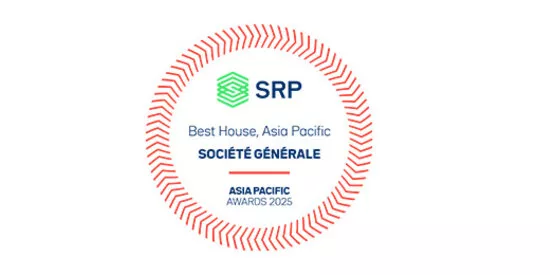
Towers, fiber and data centers: building the networks for Asia’s data revolution
By Tapan Vaishnav, Head of Advisory and Financing Group for Asia Pacific and Eugene Tan, Director, Technology, Media & Telecom (TMT) Finance for Asia Pacific at Societe Generale
A market worth several trillion dollars that is still rapidly expanding: this is the universe of Technology, Media & Telecom, better known as TMT. And while most of the headlines focus on consumer-facing software – the latest chatbot or social media application – much of the real investment and growth is to be found in the infrastructure that is enabling the digitisation of society.
Specifically, we are referring to telecom towers, 5G equipment, fiber optic cables and data centers - real assets that represent the ‘shovels’ of this particular ‘gold rush’. A few statistics prove the point: mobile telecom operators are set to spend over US$600 billion1 on capital expenditure between 2022-25 as they roll out 5G and add 400m new subscribers, mostly from Asia Pacific and Africa, to the existing 5.3 billion.
Asia also has some catching up to do regarding internet penetration, with online access for East Asia at 73% and for South Asia at just 39% compared to around 90% in the US and Europe2. In some emerging economies there is still a need for laying fiber and enabling connectivity to homes and buildings.
With the rollout of 5G proving highly capital intensive due to the short range of its antennas, many telecom operators are moving to shed other infrastructure in pursuit of an ‘asset-light’ balance sheet. In particular, this has led to them selling off their existing telecom towers (or masts).
Shedding towers, laying cables
Already a huge business in Europe and the US, the bundling of tower assets and then spinning them off into independent companies has reached Asia – in fact, it is more or less complete in Australia, Indonesia and India, while developing markets in South-east Asia and the more traditional operators in South Korea and Japan have yet to embrace this solution.
For banks and investors there is an opportunity to advise and finance these new companies. They also need regularly refinancing since loans backed by TMT collateral tend to be of a shorter tenor, say 5-7 years, than the 15-20 years seen in the power generation business.
Telcos as well as independent companies, such as internet service providers, are meanwhile busy laying fiber optic cable throughout the region – whether that is long-haul, for metro networks or last-mile access for individual households. This is creating a very successful sub-sector of broadband operators, both spin-outs and start-ups, that have huge investment needs, such as those in Australia and Hong Kong. Malaysia’s state telco is exploring the spin-off of its fiber assets, while in India most activity is still around extending networks, especially in rural areas.
At the same time, our appetite for everything from gaming to social media is creating massive demand for cloud services and hence dedicated data centers: huge halls of servers that store and manage all that digital information. The global market for data centers is expected to reach over US$400 billion3 by 2030, growing at almost 10% a year between now and then.
Going green while going big
While big technology companies are building their own, captive facilities there are also a growing number of independent operators who construct and operate data centers and lease out capacity – either to a single customer via multi-year offtake contracts, or to multiple clients according to their needs.
As data centers get bigger, with a hyperscale one housing at least 5,000 servers and providing 40 megawatts of capacity, there is a growing need to make them more sustainable by reducing power and water consumption and carbon dioxide emissions. Some operators, including Microsoft and Keppel DC in Singapore are even thinking of building sub-sea data centers to lower temperatures.
All this creates a growing need for both financing and financial advice, whether the client is a multi-national, an independent operator, or one of the increasing number of infrastructure and real-estate funds investing in this sector.
Societe Generale has a well-established TMT franchise in the US and Europe that we can draw on for expertise as we grow our team in Asia. We have deep knowledge of these markets and understand how to analyze collateral and model cashflows in this area, which can give us a competitive edge over local lenders. As one of the leading banks in sustainability and energy transition finance, we can also support clients who are working to decarbonise assets, for example by supplying them with renewable power.
The digitisation of our world is an unstoppable trend and one that promises to greatly improve the lives of millions of people, particularly in the developing economies of Asia Pacific. As responsible financiers, we are determined to play our part in making this happen.
1. The Mobile Economy 2022: https://www.gsma.com/mobileeconomy/wp-content/uploads/2022/02/280222-The-Mobile-Economy-2022.pdf
2. The World Bank Data: https://data.worldbank.org/indicator/IT.NET.USER.ZS
3. Bloomberg: https://www.bloomberg.com/press-releases/2023-01-26/data-center-market-size-worth-418-billion-by-2030-at-a-9-6-cagr-industryarc


The Asset Triple A Sustainable Infrastructure Awards 2025
Societe Generale has been recognised as the “Asia Pacific ESG Project Finance House of the Year”, “Australia Project...

Asia economic and investment outlook for second half of 2025
Where is Asia headed in the second half of this year?

Societe Generale wins Best House for Asia Pacific and Best Fixed-Income Provider at the SRP Asia Pacific Awards 2025
The Structured Retail Products (SRP) Asia Pacific Awards celebrate the top offerings and players in the structured...

Any respite for Japan’s bonds is likely to be short-term
By Stephen Spratt, APAC Developed Markets Rates Strategist at Societe Generale



